Do men do Rhythmic Gymnastics?
- Ethne Tierney
- Apr 5, 2020
- 3 min read
In this post, we are going to open Pandora's box and discuss men's rhythmic gymnastics. That's right, it does exist. And no, it is not FIG (International Gymnastics Federation) approved. There are so many questions to be answered about the gender monopoly of Rhythmic Gymnastics. Why can't men compete as Women do in World Cups, Olympic Games and whatnot? The sport is changing and since the coach of the Russian Olympic team -one of the most influential figures of RG in the world-, Irina Viner, announced she is developing and training male athletes, we can be sure we will hear a lot more about Men's Rhythmic Gymnastics in the upcoming years. In Her Releve we are all about inclusiveness, but there are reasons why men's rhythmic gymnastics is not an Olympic sport. Let's dig into this!
Currently, we find two different methods of this sport, the so-called Japanese School and the Spanish school.
JAPANESE SCHOOL

It was in the 40s when Men's Rhythmic Gymnastics (MRG) started to get popular in Japan, its country of birth. MRG, however, was not popular in the rest of the world.
Competitive Rhythmic Gymnastics as we know it nowadays started in the Soviet Union in the 1940s, and it became FIG approved in the '60s. It became part of the gymnastics discipline branch that had a masculine version of the sport, Artistic Gymnastics. Many professionals and the general public considered Rhythmic Gymnastics as the alternative feminine version of the sport, and at this stage, Men's RG wasn't even considered as an option at the time, WAG was the men's version of the sport. Men's RG didn't catch any attention as it was seen as 'too feminine'.

The Japanese school is nonetheless, not traditionally feminine at all. It's packed with strength, dynamic and powerful tumbling elements that replace the graceful moves and dance steps. Groups routines are free, meaning they don't use apparatuses. Individual routines use, just like women, clubs and rope along with men's specific double rings and stick.
SPANISH SCHOOL

Spain is the only country in the world celebrating national men's gymnastics competition under FIG rules. Although men's RG is not FIG approved the Royal Spanish Gymnastics Federation applies the current rhythmic gymnastics code of points, even if it's technically made only for women.
In other words, the Spanish School of men's gymnastics is just like women's, and it's judged the same way. In contrast with the Japanese School, men wear traditional rhythmic style unitards that look very similar to something an Olympic rhythmic gymnast would wear. We see even through the aesthetics of the sport challenges traditional gender roles. The Spanish School presents a more inclusive model of the rhythmic gymnastics style that we all know and love.
The first national-level competition was celebrated 11 years ago and every year there is more young gymnasts participating at very high standards. The president of the Spanish Federation, Ruben Esteban, claimed at a press conference that these competitions had to be organised just because the demand for them was so high. Ruben Orihuela was the first champion in 2009 when the first men's rhythmic gymnastics competition was celebrated. He is now well-known for his skill and an equality icon.
"Rhythmic was designed for women's body, but men bring something new to this sport"
-Ruben Orihuela


Will men's rhythmic gymnastics ever be an Olympic Sport? Despite the FIG opposition, this discipline sure has a bright future.
I like the idea of beginning men's rhythmic gymnastics. I like it so much that we have developed a special programme for girls and boys and we have an academy where the programme is running. Boys train from the age of three to the age of seven or eight. If they don't get on with it, they can move on to a different sport, but gymnastics is a good base for everything. Men's rhythmic gymnastics is a beautiful sport!
These are the words of the famous Irina Viner, national coach of the amazing Russian team, who is planning to develop the sport. There is no doubt that with a highly influential figure like her in charge, there is a lot yet to see about men in RG.
What school do you like best, Spanish or Japanese? Let us know what you think in the comments!




Looking forward to the day MRG is recognised by the FIG so I can finally follow my dreams